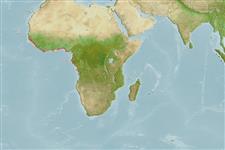Environment: milieu / climate zone / depth range / distribution range
экология
морской; пресноводный; солоноватоводный донно-пелагический. Tropical; 22°C - 26°C (Ref. 2059); 16°N - 12°S, 17°W - 16°E
Africa: coastal basins, fresh waters, brackish and marine waters from mouth of Senegal River (Senegal) to mouth of the Cuanza River (Angola) (Ref. 81260), sometimes ascending far up rivers.
Length at first maturity / Size / Вес / Возраст
Maturity: Lm 13.5, range 10 - ? cm
Max length : 30.0 cm SL самец/пол неопределен; (Ref. 31256)
колючие лучи спинного плавника (общее число) : 14 - 16; членистые (мягкие) лучи спинного плавника (общее число) : 12 - 13; колючие лучи анального плавника: 3; членистые (мягкие) лучи анального плавника: 8 - 10. Diagnosis: upper profile of head strongly convex; lower pharyngeal bone about as long as broad, and with anterior lamella shorter than toothed area (Ref. 53405). 10 or fewer rakers on lower limb of first arch; unpaired fins not predominantly red-brown; mouth terminal; 29-30 scales on lateral line; outer row teeth robust (Ref. 81260). Dorsal fin with 14-16 spines and 12-13 soft rays (total rays 27-29) (Ref. 53405, 81260). Anal fin with 3 spines and 8-10 soft rays; caudal fin weakly covered with scales at base or entirely membranous (Ref. 81260). Caudal without spots, grey on upper lobe, yellow on lower; large vertical stripes weakly pronounced on flanks; flank scales with a blackish mark at base (Ref. 53405, 81260). No bifurcated dark vertical bars on flanks; dorsal and anal without orange-red upper margin (Ref. 53405). Length of caudal peduncle 10.5-12.9% of standard length (Ref. 81260).
Very tolerant of elevated salinities, found in pure seawater, even reproduction in these highly saline environments is possible (Ref. 52307). Feeds on shrimps, bivalves, plankton (Ref. 28587), detritus (Ref. 28587, 52307), higher plants, algae, aufwuchs and small crustaceans (Ref. 52307). Oviparous (Ref. 205). Very prolific, spawning up to every 3 weeks (Ref. 52307). Pair bonding, open (Ref. 52307) substrate brooder/spawner (Ref. 52307, 81260) with both parents guarding the brood (Ref. 52307).
Oviparous (Ref. 205). Subtrate guarding of eggs as a form of parental care is done by both male and female (Ref. 50828).
Dunz, A.R. and U.K. Schliewen, 2013. Molecular phylogeny and revised classification of the haplotilapiine cichlid fishes formerly referred to as "Tilapia". Mol. Phylogenet. Evol. 68(1):64-80. (Ref. 93285)
Статус Красного Списка МСОП (Ref. 130435)
Угроза для людей
Harmless
Использование человеком
рыболовство: коммерческий; аквакультура (рыбоводство): коммерческий
дополнительная информация
инструменты
Специальные отчеты
Скачать в формате XML
ресурсы в Интернет
Estimates based on models
Preferred temperature (Ref.
123201): 25.5 - 28, mean 27.4 °C (based on 152 cells).
Phylogenetic diversity index (Ref.
82804): PD
50 = 0.5000 [Uniqueness, from 0.5 = low to 2.0 = high].
Bayesian length-weight: a=0.01514 (0.00942 - 0.02431), b=2.96 (2.83 - 3.09), in cm total length, based on LWR estimates for this species & (Sub)family-body (Ref.
93245).
Trophic level (Ref.
69278): 2.8 ±0.33 se; based on food items.
Generation time: 0.8 (0.5 - 1.3) years. Estimated as median ln(3)/K based on 10
growth studies.
устойчивость к внешним воздействиям (Ref.
120179): высокий, минимальное время удвоения популяции до 15 месяцев (K=0.47; Fec < 1,000).
Fishing Vulnerability (Ref.
59153): Low vulnerability (19 of 100).
